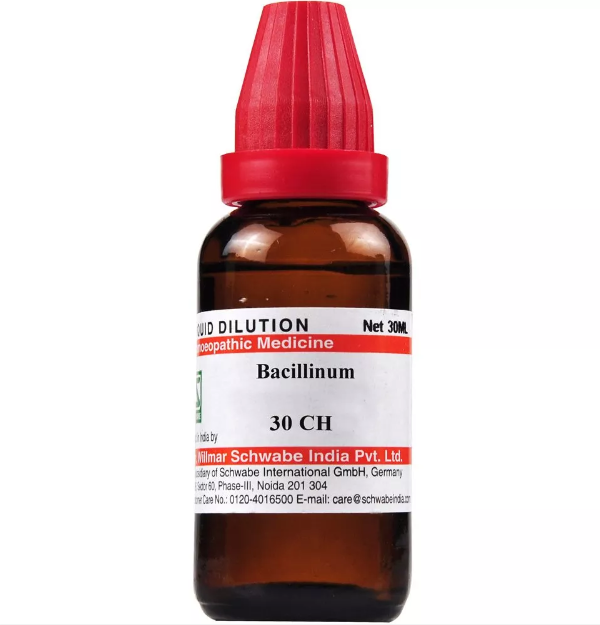BACILLINUM BURNETT 6C, 12C, 30C, 200C, 1M, 10M USES AND SYMPTOMS
 Bacillinum Burnett is a remedy derived from a typical tuberculous lung and has shown success in treating tuberculosis. It notably improves sputum production, making it less purulent and more aerated. It’s beneficial for various chronic non-tubercular conditions, especially when bronchorrhea and dyspnea are present. Bacillinum suits elderly individuals with chronic lung issues and suffocative symptoms at night. It aids in reducing tartar on teeth and helps prevent constant colds.
Bacillinum Burnett is a remedy derived from a typical tuberculous lung and has shown success in treating tuberculosis. It notably improves sputum production, making it less purulent and more aerated. It’s beneficial for various chronic non-tubercular conditions, especially when bronchorrhea and dyspnea are present. Bacillinum suits elderly individuals with chronic lung issues and suffocative symptoms at night. It aids in reducing tartar on teeth and helps prevent constant colds.
Head: Irritability, deep-seated headaches, sensation of tightness around the head.
Abdomen: Abdominal pains, enlarged glands in groins, sudden diarrhea before breakfast, obstinate constipation.
Respiratory: Oppression, catarrhal dyspnea, humid asthma, bubbling rales, muco-purulent expectoration.
Skin: Ringworm, eczema of eyelids, enlarged and tender neck glands.
Modalities:
Worse: Night and early morning, cold air.
Relationship:
Ant-i., Lach., Ars-i., Myos-a., Lev. are related remedies.
Complementary: Calc-p., Kali-c.
Comparison:
Similar effects to Koch’s Tuberculinum; useful in early stages of tubercular diseases.
Chronic equivalent to Psor.
Dosage:
Administered above the thirtieth potency, not repeated frequently. One dose weekly often suffices for a reaction. Rapid action expected, with good results indicating effectiveness.
SYMPTOMS OF BACILLINUM BURNETT
Head Symptoms:
Irritability
Deep-seated headaches
Sensation of tightness around the head
Abdominal Symptoms:
Abdominal pains
Enlarged glands in groins
Sudden diarrhea before breakfast
Obstinate constipation
Respiratory Symptoms:
Oppression
Catarrhal dyspnea
Humid asthma
Bubbling rales
Muco-purulent expectoration
Skin Symptoms:
Ringworm
Eczema of eyelids
Enlarged and tender neck glands
Modalities:
Worse at night and early morning
Worse in cold air
Relationships:
Related to Ant-i., Lach., Ars-i., Myos-a., Lev.
Complementary to Calc-p., Kali-c.
Comparison:
Similar effects to Koch’s Tuberculinum
Chronic equivalent to Psor.
Dosage:
Administered above the thirtieth potency
Not repeated frequently
One dose weekly often sufficient
selection of the potency
Individualization:
- Homeopathy is based on the principle of treating the individual, not just the disease. The unique symptoms and characteristics of the person are crucial in determining the most suitable potency.
Intensity of Symptoms:
- The intensity of the symptoms guides the choice of potency. If the symptoms are intense and acute, a lower potency (e.g., 6C, 30C) might be considered. For chronic conditions with less intensity, higher potencies (e.g., 200C, 1M) may be appropriate.
Sensitivity of the Patient:
- Some individuals are more sensitive to homeopathic remedies, while others may require higher potencies. The practitioner considers the patient’s sensitivity when selecting the potency.
Acute vs. Chronic Conditions:
- Lower potencies are often used for acute conditions, while higher potencies may be considered for chronic or long-standing issues.
Previous Response to Potencies:
- The patient’s response to previous homeopathic treatments helps guide the choice of potency. If a particular potency has been effective in the past, it may be repeated or adjusted as needed.
Vital Force and Susceptibility:
- Homeopathy views illness as a disturbance in the vital force. The practitioner assesses the patient’s overall vitality and susceptibility to determine the appropriate potency.
Aggravation or Amelioration:
- The direction of the symptom response (aggravation or amelioration) after taking a remedy can influence the choice of potency.
Miasmatic Considerations:
- In classical homeopathy, the concept of miasms (inherited disease tendencies) is considered. The practitioner take this into account when selecting the potency.
Practitioner Experience:
- The experience and preference of the homeopathic practitioner play a role. Some practitioners may have success with certain potencies based on their clinical experience.
SAFETY INFORMATION
- Do not exceed the recommended dose by physician
- Keep out of the reach of children
- Store in a cool dry place away from direct sunlight
- Maintain half an hour gap between food/drink/any other medicines and homoeopathic medicine
- Avoid any strong smell in the mouth while taking medicine e.g. camphor, garlic, onion, coffee, hing
Medicine images use for reference only selection of homeopathic medicine depends on the individual’s specific symptoms and overall constitution. Moreover, homeopathy is a holistic system of medicine that treats the individual as a whole. In addition to addressing the physical symptoms, it takes into account the emotional and mental state of the person. Consequently, it’s crucial to consult with a qualified homeopathic practitioner for personalized treatment.
The information provided on this website is intended solely for educational purposes. Always seek the advice of your physician or other qualified health provider.
